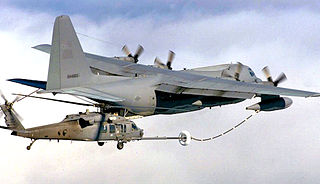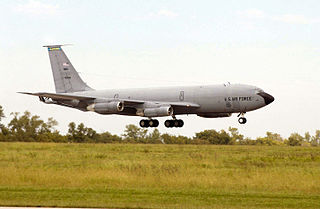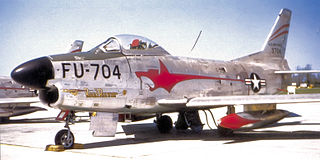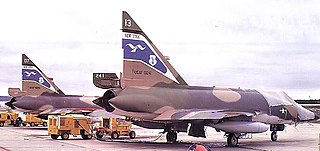114th Fighter Squadron  | |
|---|---|
 114th Fighter Squadron F-15C Eagle [lower-alpha 1] | |
| Active | 1942–1945; 1946–1952; 1952–1958; 1984–present |
| Country | |
| Allegiance | |
| Branch | |
| Role | ANG interceptor training |
| Part of | Oregon Air National Guard |
| Garrison/HQ | Kingsley Field Air National Guard Base, Klamath Falls, Oregon |
| Nickname(s) | Eager Beavers [1] |
| Motto(s) | The Land of No Slack[ citation needed ] |
| Engagements | European Theater of Operations Pacific Ocean Theater of World War II |
| Decorations | Distinguished Unit Citation Air Force Outstanding Unit Award French Croix de Guerre with Palm |
| Insignia | |
| 114th Fighter Squadron emblem |  |
| 439th Bombardment Squadron emblem [2] |  |
The 114th Fighter Squadron is a unit of the Oregon Air National Guard 173d Fighter Wing located at Kingsley Field Air National Guard Base, Klamath Falls, Oregon. The 114th is equipped with the McDonnell Douglas F-15C Eagle.
Contents
- Mission
- History
- World War II
- New York Air National Guard
- Oregon Air National Guard
- Lineage
- Assignments
- Stations
- Aircraft
- Awards and campaigns
- See also
- References
- Notes
- Bibliography
- External links
The first predecessor of the squadron was activated in June 1942 as the 439th Bombardment Squadron and equipped with the Martin B-26 Marauder. After training in the United States, it deployed to the Mediterranean Theater of Operationsl, where its actions in combat earned it two Distinguished Unit Citation and a French Croix de Guerre with Palm. In late 1944, it was withdrawn from combat operations and returned to the United States, where it converted to the Douglas A-26 Invader. It moved to Okinawa, where it engaged in combat against Japan. Following V-J Day, the squadron returned to the United States and was inactivated.
In 1946, the squadron was allotted to the National Guard and redesignated the 114th Bombardment Squadron. It activated in New York and was again equipped with the Invader, which was called the B-26 after 1948. In 1951, the squadron was called to active duty for the Korean War. It did not depart the United States, however, leaving its B-26s behind to become a training unit for Boeing B-29 Superfortress aircrews. In December 1952, it was relieved from active duty. It turned its B-29s over to a regular unit and returned to its B-26 Invaders in New York. In 1957, it assumed an air defense mission as the 114th Fighter-Interceptor Squadron, but its interceptor aircraft were soon withdrawn and it remained a paper unit until inactivating in September 1958 and being withdrawn from the New York National Guard.
The squadron's second predecessor was formed in the Oregon Air National Guard in February 1984 as the 114th Tactical Fighter Training Squadron,taking over the resources of the 8123rd Fighter-Interceptor Training Squadron, which had been organized the previous year to train Air National Guard McDonnell Douglas F-4C Phantom II crews in the air defense mission. In August 1987, the two squadrons were consolidated into a single unit. It has continued the interceptor mission since, twice trading in its fighters for newer models.
























